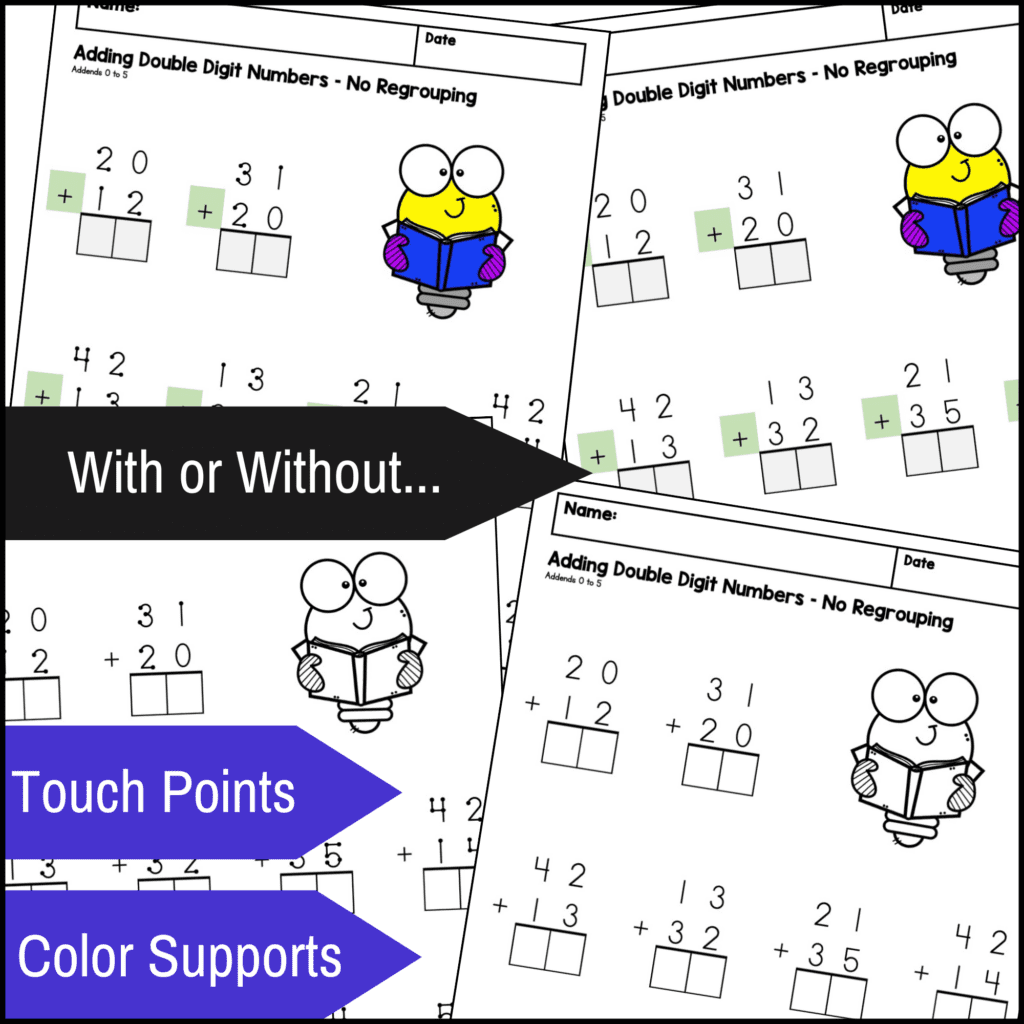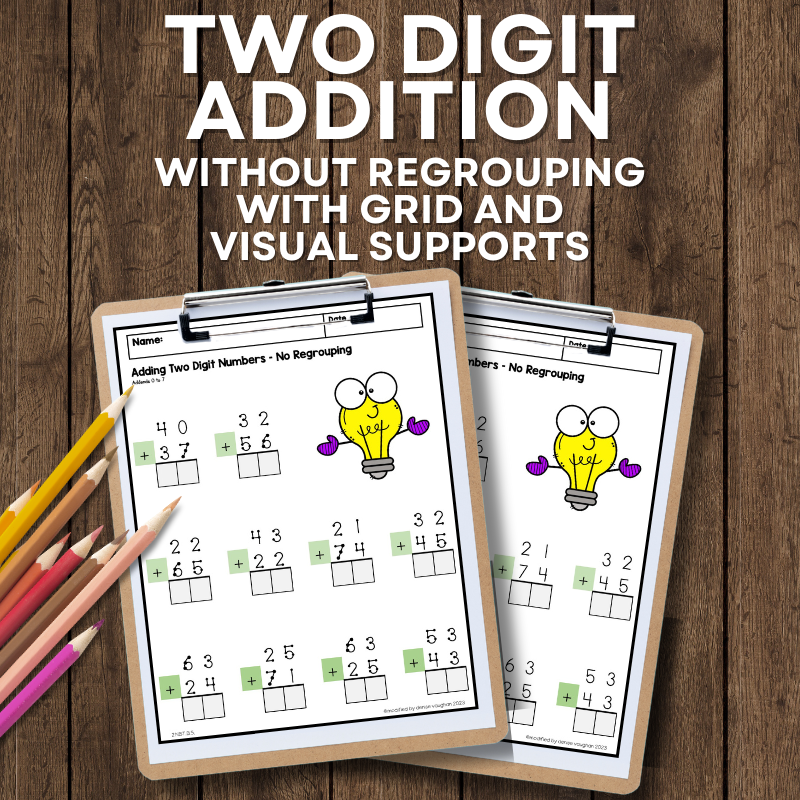Teaching addition can be challenging at times. Despite explanations, demonstrations, and hands-on tools, some students struggle to understand. The combination of numbers can become blurry, leading to frustration for both the students and the teacher. However, here’s a secret: visual supports such as touch points, grid lines, and color are effective strategies for teaching addition that can bring clarity and confidence to even the most resistant learners. These simple tools break down complex math problems into manageable steps, ultimately helping students grasp addition. Are you ready to discover the key to unlocking math success and making addition easier for both students and teachers?
Why Visual Supports are Effective Strategies for Teaching Addition

Addition can be tough for students who struggle with number sense or organization. Visual supports, like touch points and grid lines, give these learners a roadmap, turning math from a maze into a manageable path. These tools are effective strategies for teaching addition that provide structure, helping students break down problems into smaller, doable steps. For experienced teachers, using visual supports means fewer frustrating math sessions and more “aha!” moments as students start to understand addition in a way that makes sense to them.
Touch Points: Bringing Numbers to Life
Touch points are a simple, powerful way to make numbers tangible. Each number from 1 to 9 has a specific number of “touch points” (or dots) that correspond to its value. For example, the number 3 will have three touch points, and so on. For students who need a concrete, tactile way to see what a number represents, touch points can feel like a breakthrough.

- How It Works: When students see a number with touch points, they no longer have to guess or memorize—they can count the points to understand the value. This makes addition easier by turning abstract numbers into something students can physically count.
- Teaching the “Count-On” Strategy: Here’s where touch points shine. Let’s say you’re adding 3 + 5. Instead of starting from scratch, teach students to “count on.” They start with the bigger number (5) in their head and then use the touch points on the smaller number (3) to count up: “5…6, 7, 8.” This approach simplifies addition, allowing students to work with manageable numbers and gradually build confidence in their math skills.
Quick Tip: Laminate the touch points charts or put them in a protective sleeve cover so students can physically touch or even trace the dots as they count. This tactile interaction can be a real help for kinesthetic learners!
Grid Lines: Staying Organized and Aligned

For students who struggle with organizing numbers, keeping columns aligned can be half the battle with addition. Grid lines are another effective strategies for teaching addition that give students a straightforward way to keep numbers in the correct place, making addition less overwhelming and more organized.
- Keeping Columns in Check: With grid lines, each digit has a designated “home,” which helps students keep tens, ones, and, eventually, hundreds properly aligned. This eliminates a common frustration—mixing up columns—and helps students avoid simple errors that can quickly add up.
- How to Use Grids: Give students grid-lined paper or pre-made worksheets with clearly defined spaces for each digit. The structure helps them focus on the math rather than worrying about where to write each number.
Bonus Benefit: Once students are comfortable with addition on a grid, they’ll feel more prepared for larger problems, like multi-digit addition or subtraction with regrouping. Grids help establish the habit of neat, structured math work early on, which can be a huge help as students move on to more complex concepts.
Highlighting the Operation: Directing Attention to What Matters
Sometimes, a small visual cue is another way to use effective strategies for teaching addition that can make a big difference in how students approach a math problem. For many struggling learners, this simple color cue reduces confusion, helping them stay focused on the task and reinforcing the concept that they’re adding, not subtracting or performing another operation.

- Why It Works: Highlighting the addition sign as a visual support gives students an immediate reminder of the operation they’re working on. This is especially helpful for learners who may struggle with math anxiety or get easily distracted, as it gives them a “go-to” visual to keep them on track.
- Where to Use It: These worksheets are ideal for introducing addition to students who are just starting out or those who benefit from repeated, visual cues. The highlighted “+” sign can be gradually faded out as students build confidence with the addition process on their own.
A Strategy that Sticks

One of the best things about using visual supports like touch points, grid lines, and highlighted operations is that they’re flexible tools and effective strategies for teaching addition that are easy to use for building foundational math skills that stick. Each support can be an effective strategy for teaching addition as well as other operations it gives students exactly what they need to solve problems confidently, and over time, these can be gradually phased out as students gain mastery.
Touch points make counting manageable, grid lines keep everything organized, and the green-highlighted “+” sign keeps them focused on the correct operation—helping to avoid mistakes and ease math anxiety. Together, these supports offer a clear path for students to approach addition independently. As students grow more confident, you can slowly remove these visuals, allowing them to rely more on their own math skills.
Visual aids aren’t just short-term fixes; they’re scaffolds that help students build lasting confidence. When students experience math success with addition through these effective strategies for teaching addition supports, they develop a positive mindset about math and a strong foundation for future learning.
Ready to make addition easier for your students?
Sign up for my email list, and you’ll get instant access to a free resource: 2-Digit Addition Without Regrouping Touch + Count No Prep Worksheets FREEBIE! This freebie includes 3 pages of two-digit addition problems with grid support, provided in four versions—color or black-and-white, with or without touch+count numbers. Use these worksheets to scaffold learning as students master touch points or adapt them to meet different support levels in your class. With these ready-to-go, low-prep resources, you can start building confidence and clarity in your students’ math skills today!
Just enter your email below to get your free copy and start simplifying addition for your students.

Ready to Dive Deeper into Two-Digit Addition?

Get this set of 12 scaffolded worksheets designed to meet the needs of all your students. With visual supports, customizable options, and a range of difficulty levels, these worksheets are perfect for warm-ups, classwork, IEP goal tracking, and more! Click here to purchase the full set and give your students the extra practice they need to succeed.
Effective Strategies for Teaching Addition to All Students
These strategies—touch points, grid lines, and highlighting the operation—are often used by special education teachers working with students with learning disabilities, autism spectrum disorder (ASD), or other unique learning needs. However, they are also effective strategies for teaching addition to any student. In fact, did you know that about 1 in 5 students has a disability? That means these visual supports could benefit every classroom, helping not only students with disabilities but also those who just need a little extra structure or support. Whether you’re teaching in a general education setting or working with students who need more scaffolding, these simple tools can make addition clearer and more accessible for all learners.

